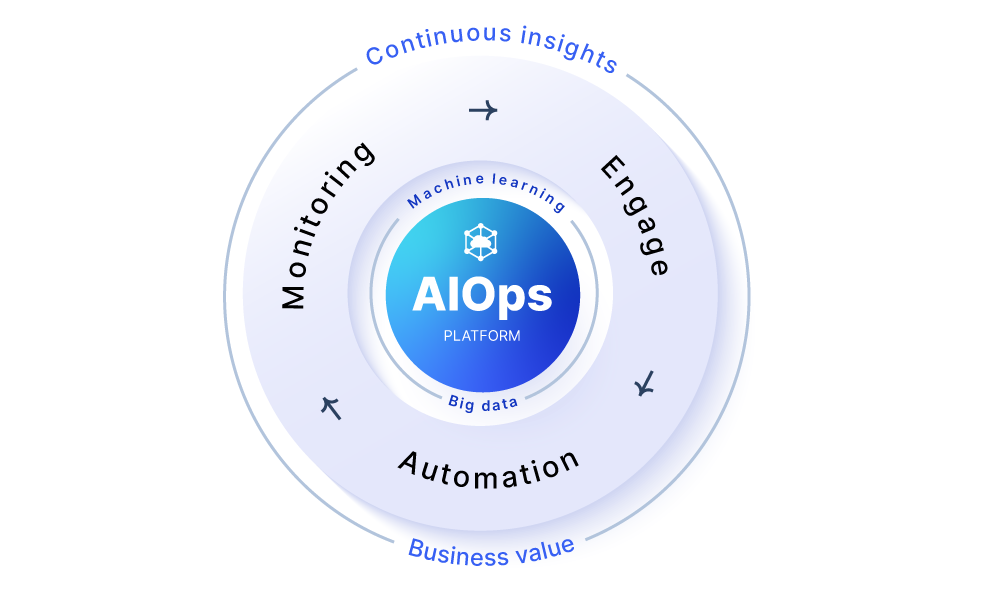What Is AIOps? Understanding Its Importance and How to Adopt It

What is AIOps?
The connection between DevOps and artificial intelligence operations (AIOps) has become increasingly evident and has reshaped how you can manage and optimize systems.
AIOps is the practice of applying artificial intelligence, machine learning, and advanced analytics to automate and improve IT operations. As stated by Gartner, algorithmic IT operations platforms enable I&O leaders to meet the proactive, personal, and dynamic demands of digital business by transforming the very nature of IT operations work via unprecedented, automated insight.
Traditional monitoring and alerting methods, often called a “black box approach,” offered limited insight into system performance.
AIOps leverages AI technologies such as machine learning, advanced analytics, and big data to automate and enhance IT operations.
By processing vast amounts of data in real-time, AIOps enables your team to predict potential issues, reduce manual interventions, and improve overall efficiency.
Features and Benefits of AiOps
For today’s businesses, there’s a premium on delivering an optimal digital customer experience—all the time and every time.
AIOps is pivotal in enabling IT and DevOps teams to meet these demands. The most apparent benefit of AIOps is how they allow you to do more with less—operating faster, more efficiently, and with more knowledge—so you can scale.
AIOps transforms traditional IT processes into agile, intelligent systems. It leverages real-time analytics, machine learning, and big data to enhance decision-making, improve operational efficiencies, and reduce downtime.
Let’s explore some key features of AIOps and how they benefit your IT operations.
-
Real-time Analytics
AIOps allows IT teams to monitor systems and applications in real-time, analyze data to detect anomalies, pinpoint bottlenecks, and prevent incidents before they impact end users.
This helps operations teams identify issues swiftly, reducing mean time to detection (MTTD) and improving system performance.
-
Automated Root Cause Analysis
Finding the root cause of IT incidents can be time-consuming and complex. Automated incident management streamlines root cause analysis using advanced machine learning algorithms and event correlation.
AIOps aggregates and analyzes data from multiple sources, providing clear insights into the underlying causes of issues. This accelerates troubleshooting, minimizes human error, and reduces the impact on business operations.
-
Predictive Technology
AIOps goes beyond reactive operations by using predictive analytics to anticipate potential issues before they become major incidents.
Analyzing historical data lets your team predict system failures, capacity shortages, and performance degradation.
-
Scalability
Modern IT environments are dynamic and constantly evolving. AIOps offer scalability, allowing your organization to adapt to growing infrastructure and increasing data volumes seamlessly.
Whether you’re dealing with a handful of systems or an expansive global network, AIOps scales effortlessly to meet the demands of large, complex environments. This scalability ensures that IT teams maintain high performance and availability at scale.
-
Collaboration Enhancement
AIOps also fosters enhanced collaboration among IT, DevOps, and other teams by democratizing access to critical insights. Traditionally, knowledge about specific systems or incidents might reside with a few team members, leading to inefficiencies.
AIOps helps you break down these silos by providing complete visibility across your organization, ensuring that all team members have access to the same data. This transparency enables better collaboration, communication, and decision-making.
-
Automated Incident Resolution
AIOps platforms aim to enhance the quality of ingested data by identifying patterns and forecasting emerging behaviors. This analytics-driven approach simplifies root cause identification and triggers automated actions to resolve issues faster.
AIOps platforms like xMatters provide automated incident resolution and response, enabling you to review incident details in seconds from a unified console designed for team collaboration. You can easily see who is on call and track team efforts as they work toward resolving issues.
-
Customizable Dashboards
This allows your team to visualize data in ways that are most relevant to current needs. These dashboards can be tailored to display key metrics, alerts, and performance indicators, enabling teams to identify trends and monitor critical systems quickly.
By providing an intuitive and flexible interface, AIOps ensures that IT and DevOps teams can focus on the metrics that matter most, improving overall efficiency and response times.
How Does AIOps Work?

As we have learned, AIOps combines core technologies, including machine learning algorithms, big data analytics, and automation frameworks, to manage and optimize the growing complexity of modern IT environments.
With today’s highly complex systems, developers and engineers face floods of alerts, yet only a handful matters. Alert fatigue is common, so critical alerts are often buried and ignored.
With an AIOps solution, you can correlate, suppress, and prioritize alerts. This means that your team can focus on issues that are the most critical to reliability.
In short, AIOps provides IT teams with enriched insights and automation to find and resolve problems faster.
AIOps Use Cases
AIOps offers various applications that help IT teams improve operational efficiency, reduce downtime, and drive innovation across sectors like DevOps and cloud infrastructure. Let’s explore how.
Incident Management and Resolution
At Everbridge xMatters, we automate the detection and resolution of incidents, minimizing service disruptions with efficient incident management software.
By leveraging real-time insights, automation workflows, and advanced analytics, we can reduce the time required to resolve incidents, limiting business impact.
AIOps tools identify patterns and predict potential issues to ensure incidents are managed efficiently and consistently, even as digital complexity grows.
Capacity Planning and Resource Optimization
AIOps solutions can predict future resource needs and optimize infrastructure allocation by analyzing historical data and real-time metrics.
For instance, at xMatters, our solution integrates AI-driven analytics to monitor usage patterns and optimize resources across hybrid and multi-cloud environments.
This helps you prevent over-provisioning or under-utilization, ensuring efficient use of resources while maintaining peak performance.
Performance Analysis
By continuously monitoring system performance, AIOps platforms can detect performance degradation before it impacts end users.
Utilizing AI to correlate data across applications, infrastructure, and services to identify bottlenecks or inefficiencies. This allows IT teams to optimize performance proactively, improving service quality and reducing downtime for critical applications.
Anomaly Detection
AIOps platforms excel at anomaly detection by using machine learning models to understand normal operational behavior and flag unusual patterns.
At xMatters, we apply AI to analyze thousands of metrics across IT systems in real-time. When abnormal behavior is detected—such as unexpected spikes in network traffic or application errors—our AIOps solution triggers automated responses or alerts IT teams to take immediate action.
Automated Change Management
Change management is vital yet challenging. AIOps simplifies this by automating the identification and application of changes that align with system requirements.
Our solution uses AI to surface meaningful change information during incidents, helping teams identify recently modified services that might be causing problems.
Integrating these insights into the broader incident response framework helps your teams manage changes efficiently, reducing the risk of unintended consequences from system updates or patches.
AIOps Adoption: Best Practices for Seamless Integration
Successfully integrating AIOps into your IT operations or incident management for DevOps setup doesn’t have to be overwhelming.
Here are seven best practices for smooth and effective AIOps integration:
-
Assessing Current Capabilities
From the get-go, it can be tricky to accurately size up what you need from AIOps and estimate how much time and effort it will require to integrate it into your systems.
Taking the time to scope out what you want to accomplish and your current capabilities is worthwhile. Start by identifying your team’s pain points—such as alert fatigue or slow incident responses—and determining where AIOps can most impact.
-
Selecting the Right AIOps Tools
You want a platform that scales with your business, integrates easily with your existing tools, and offers automation features that reduce manual work.
Also, look for something user-friendly, like low-code to no-code tools, so everyone on your team can benefit from them. The truth is most organizations can leverage solutions with built-in data science so they can enjoy the data science benefits of AIOps without data scientists.
-
Training Staff
Get your team up to speed on how AIOps works and how it will improve their day-to-day tasks. A typical response to the proposal of an AIOps project is the fear of change. Employees enjoy familiarity with the tools they already have and can resist change.
Make it clear that AIOps is about reducing repetitive tasks, not replacing jobs. Showing the benefits—like quicker problem-solving and fewer disruptions—will help get everyone on board.
-
Phased Implementation
Don’t try to do everything at once. Start small, focusing on high-impact areas like incident management for IT operations or anomaly detection. This phased approach helps you adjust and refine as you go, making the process easier for everyone involved.
-
Continuous Evaluation
Once AIOps is up and running, keep an eye on how it’s performing. Measure its success with metrics like improved system uptime or reduced response times. Regular reviews will ensure your AIOps strategy aligns with your evolving business needs.
-
Encouraging Collaboration
For AIOps to truly shine, teams need to collaborate. Foster a culture where IT, DevOps, and business teams share insights and work together. This way, everyone can benefit from AIOps and contribute to continuous improvement.
-
Maintaining Data Integrity
Finally, remember that AIOps is only as good as the data it’s based on. Make sure the data you feed into it is accurate and up-to-date. This ensures the insights you get are reliable and actionable.
Embracing AIOps
AIOps can transform IT operations and DevOps through automation, predictive analytics, and intelligent decision-making.
Developing trust in your AIOps solution starts with having visibility from the inside out. For example, the event correlation and automation platform BigPanda allows users complete control over which correlation patterns are active at any given time.
They can review them, test them against their data, tweak them if needed, and test them again so they can have complete confidence before deploying them to production.
There’s a general tendency to let AIOps adoption drag on, believing it will take a year or two to get the correct value. In reality, it shouldn’t take that long. Platforms like Everbridge xMatters help simplify and expedite that process.
Looking for more insights? Check out our new AIOps Buyer’s Guide and discover the best use cases and key capabilities of the right AIOps tool.
